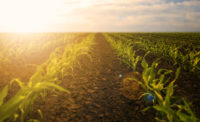Study: California dairies must prepare for tougher environmental regulations
Looming regulations aimed at mitigating surface and groundwater contamination and greenhouse gas emissions will spur higher operational costs and complexity.

The California dairy business is not getting any easier, according to a new report by the Food & Agribusiness Research (FAR) and Advisory, a Netherlands-based wholly owned unit of Rabobank Group, which also owns Roseville, Calif.-based Rabobank N.A. Looming regulations aimed at mitigating surface and groundwater contamination and greenhouse gas emissions will spur higher operational costs and complexity.
The report, "Digesting Environmental Policy: California Dairies are Swimming in It," contends that dairies that invest in new technology and increasingly incorporate environmental management into their routine farming practices will be in the best position to sustain their businesses and potentially realize new revenue streams.
"The nation's largest milk-producing state faces real but surmountable regulatory hurdles in the coming years," says James Williamson, an analyst with Rabobank's FAR unit. "By researching and planning now, California dairy owners can consider capital investments in solutions like sub-surface drip irrigation for forage and croplands, anaerobic digesters that convert methane into energy and other options currently being explored. Along with new-era management practices, dairies can tackle compliance demands, while supporting long-term profitability goals."
FAR's extensive report addresses a number of issues, including:
- Water regulations are becoming increasingly important and will impact both surface and groundwater withdrawals. Dairies that utilize sub-surface drip irrigation and precision crop management can increase their forage crop yields, and potentially free up to 25% of dairy lands for other investments.
- The cost of greenhouse-reducing, energy-generating anaerobic digesters can be offset for dairies that can realize economies of scale and afford major capital expenditures. Some digester investments may even become profitable. However, if production costs continue to increase, as is expected, some dairy owners may choose to retire or consolidate their businesses.
- Dairy coalitions, especially in the Central Valley, are becoming increasingly important for managing the state's evolving water-related regulations. For example, a working group comprised of more than 95% of the Central Valley's dairies are researching best practice guidelines for protecting groundwater.
"There are real examples today of dairies sharing both the costs and revenues," says Williamson. "Sometimes, it can mean the difference between staying in business independently and leaving it altogether. The important thing is to fully appreciate the industry's current and future challenges, and know what options are available now and in the long term."
Looking for a reprint of this article?
From high-res PDFs to custom plaques, order your copy today!





